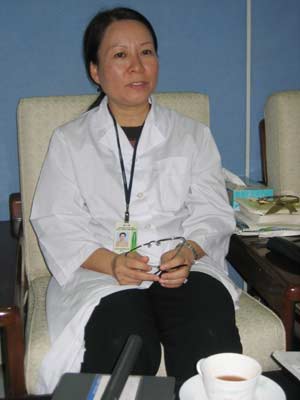Who volunteered to test the H5N1 vaccine?
Before the information about the strain of H5N1 virus, the National Institute of Hygiene and Epidemiology affirmed: "H5N1 virus has appeared for more than 2 years, of course, there must be signs of change. However, influenza A / H5N1 vaccine that the world and Vietnam are working on are still highly effective, protecting the current pre-mutated humans of the H5N1 virus ".

Prof. Nguyen Thu Van, a member of the research group, produced H5N1 vaccine
After confirming this, GS. Nguyen Thu Van - Director of Vaccine Company and No. 1 biological product (belonging to NIHE) said that only when a pandemic happened, meaning that H5N1 has been mutated strongly from person to person, the H5N1 vaccine being studied is no longer effective. .
Therefore, when this worst case has not yet occurred, the release of the H5N1 vaccine is still essential.
Vietnam Vaccine: Cheap, safe
Previously, world vaccine manufacturers all use traditional technology to produce eggs with embryos that do not carry specific pathogens (SPF: Specific Pathogen Free).
This means that the vaccine must be produced in completely sterile facilities. While the investment budget for building such a facility is very large; The price of an embryonic chicken egg is also very high.
This kind of "clean" eggs, Vietnam often has to import from countries. However, eggs imported through intermediate transports will no longer guarantee quality, leading to danger to vaccine people.
Moreover, vaccine production on chicken eggs also has other limitations such as viral titre (the possibility of virus replication, antibody production) is not high; 2-4 eggs will receive one dose of vaccine for humans.
Not to mention, even through refined stages, there is still a certain amount of Ovalbumin that cannot be eliminated in the egg - this is one of the causes of allergy and sensitivity in humans. Time to produce a series of flu vaccines on chicken eggs takes 4 - 6 months.

Testing H5N1 vaccine on monkeys in Quang Ninh
After considering these difficulties, the research team of the Central Institute of Hygiene and Epidemiology has chosen its own approach and aims to produce A / H5N1 influenza vaccine from the first monkey kidney cell.
In a suitable environment, good culture, the amount of seed virus will be multiplied and become a source of "raw material" for vaccine production. The H5N1 strain of the virus that the institute was isolated from samples of patients infected with avian influenza in a northern province.
Along with the experience in producing hepatitis A vaccine, polio and international cooperation, the team has implemented the method of "cell culture" and is considered to be the shortest path, effective in vaccine production.
By this time, no country in the world with H5N1 vaccine has been granted a circulation license. In addition to the two countries that have completed a preliminary clinical trial of the United States and Hungary, many countries are still in the stage of trial production or field preparation, including Vietnam.
The estimated cost of Vietnamese vaccines will be very cheap, about 30,000 VND / nose.
About the ability to meet the demand for vaccination in Vietnam and GS. Van said that the Institute could only produce 2-3 million doses per year, just enough for about 1 million people.
Who was the first to get a vaccine?

Scientists of the National Institute of Hygiene and Epidemiology continue to work on the H5N1 vaccine they are pursuing
Talking to PV VietNamNet in the H5N1 vaccine area, GS. Nguyen Thu Van is pleased to announce: '' Vietnam has successfully produced 6 series of H5N1 vaccines for humans. The vaccine sample of 6 trial production series has been thoroughly tested according to the minimum requirements of the World Health Organization (WHO), sent to WHO laboratories ''.
Previously, scientists at the Central Institute of Hygiene and Epidemiology had completed the research journey, producing H5N1 vaccine with animal tests. After being accepted by WHO, the Institute will test this vaccine on a group of volunteers.
GS. Van said: '' Selecting testers will be very strict. Since the first study of production, the people who directly worked on it have volunteered to give it a try, but not yet have been selected . "
Volunteer groups will have about 20-30 people, no contact with poultry for 15 days before the vaccine test, will be given 2-3 shots within 2-3 months. Of course, we will choose very carefully, will announce this when after being allowed to experiment on people, "- Prof. Thu Van informed.
However, when asked specifically about the volunteers, Professor Van refused to reveal."Science cannot be joke. Choosing a person to test for a vaccine cannot predict premature aging. Only when we have a specific person will we announce it."
After H5N1 vaccine is allowed to circulate, scientists will have many more interesting stories about the journey of H5N1 vaccine "made in Vietnam" .
Le Ha
- The H5N1 vaccine 'made in Vietnam' is about to be tested on humans
- Vaccine is resistant to bird flu
- March 2012: Launching H5N1 vaccine for poultry
- Nha Trang vaccine institute produces H5N1 vaccine
- Hungary prepared the vaccine against H5N1 virus
- Detection of the H5N1 virus strain by a test
- No vaccine against H5N1 has been detected in Vietnam
- Glaxo has a vaccine against H5N1
- The new cancer vaccine has just been injected into the first patient in the United States
- Injecting two trials of H5N1 vaccine made in Vietnam
- Testing H5N1 vaccine in Australia
- In 2009, there will be H5N1 vaccine
 March 2012: Launching H5N1 vaccine for poultry
March 2012: Launching H5N1 vaccine for poultry Experts comment on the mysterious gradual disappearance of the Delta variant in Japan
Experts comment on the mysterious gradual disappearance of the Delta variant in Japan Danger of the two Delta . branch variants
Danger of the two Delta . branch variants 2020 pandemic flu attack humans?
2020 pandemic flu attack humans?